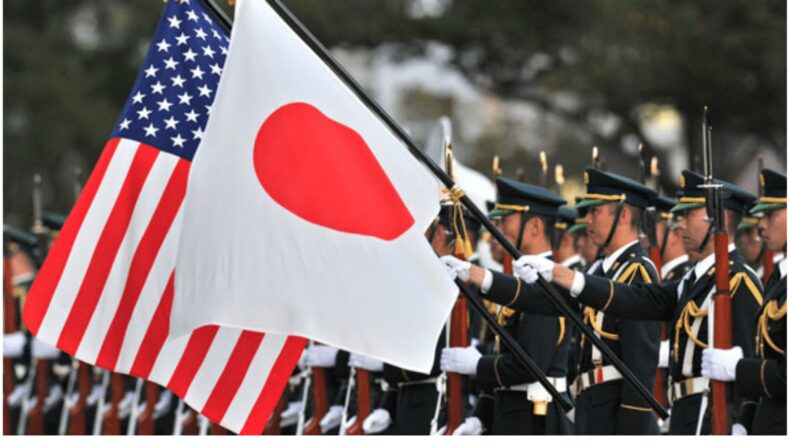Senior officials of USA & Japan announced a significant strengthening & restructuring of military cooperation between the two nations on Wednesday, at the annual US-Japan Security Consultative Committee Meeting. The upgrade in the bilateral relationship is marked by the deployment of a restructured Marine regiment which possesses much more defense & offense capability than its predecessor.

The meeting on Wednesday was a ‘2+2 Consultation’ – attended by the Ministerial heads of Defense & Foreign Affairs of both nations. This meeting took place only days before US President Joe Biden is set to host Japanese Prime Minister Fumio Kishida at the White House, reflecting the increasing synergy in their ‘Strategic Alliance’. During a press conference held after the consultation, US Defence Secretary Lloyd Austin announced in consonance with the other dignitaries, the redesignation of the artillery core ‘12th Marine Regiment’ into the ‘12th Marine Littoral Regiment’. Here is what the Secretary had to say about the move,
“We ARE replacing an artillery regiment with an outfit that’s more lethal, more agile, & more capable.”
Lloyd Austin (Secretary of Defence – USA)
The strengthening of security cooperation comes in the background of many factors – a shift in USA’s geopolitical interests, the increasing strategic importance of Japan, a transformation of military capabilities, and an overall need to counter a growing China in the region.
USA’s Shift In Geopolitical Interests

The 12th Marine Littoral Regiment is to be based out of Okinawa, Japan and as per the Press Release of the ‘2+2 Consultation’, is aimed at ‘bolstering deterrence in the region’ which will allow the US to defend Japan and its people more effectively. Okinawa is strategically important to the US, vis-a-vis its proximity to Taiwan and thus houses more than 70% of all US military installations in Japan. As experts at the Council of Foreign Relations inform, one of the islands of Okinawa in which the US has a military base lies within 70 miles of Taiwan (see below).

The deployment of the more advanced regiment in the region is just one of many military adjustments that the US has made in recent years, and this is reflective of a broader shift in geopolitical interests. As sources indicate, The US Pentagon showcases its future interests in the Indo-Pacific and is thus moving on from its commitments in the Middle East towards this region. The fact that this move puts the USA in the backyard of China is no coincidence, as conflict rises between the two powers.
The White House released the ‘Indo-Pacific Strategy’ White Paper in the previous year, and it clearly reflects this shift by stating that the USA has ‘long recognised’ the Indo-Pacific as vital to their security and prosperity, and displays the importance of this region as one which drives two-thirds of global economic growth. The document also indicates the need to combat China’s ‘economic, diplomatic, military and technological might’ in the region.
Trusting Japan with the Armory Keys

The move to put advanced forces in Japan does not come as an isolated incident – quite recently Japan itself announced its new national security plan which signals towards the ongoing military buildup in the nation that is the largest since its demilitarization after the Second World War. The USA had designed Japan’s postwar constitution on pacifist lines – so that it never rises up to become a threat again.
However Japan’s recent move not only goes unopposed by the US, but rather gets diplomatic approval. Apart from its partnerships with the US, Japan recently signed a ‘historical’ bilateral defense pact with Britain to enable easier joint military exercises and to deploy forces in each other’s countries. Japan’s growing strategic importance is attributed to the changing attitude of the Western nations which are considering strengthened alliances with the country.

China has been amping up its naval presence in areas near Japan and has been claiming sovereign authority over the Senkaku island chain (see above) that has been under the control of Japan. Japan’s presence in the Indo-Pacific and its stakes in the South-China Sea through the Senkaku islands reflects its growing alliance with US & NATO member states – who in turn look towards Japan for forward deployment and basing options to gain a foothold in the region.
Modern Warfare

The redesignated Marine unit is aimed at being more than just US presence in a foreign nation – as US officials note, it is intended to provide a stand-in force that is able to defend Japan and quickly respond to contingencies. US defense personnel have described the “Marine Littoral Regiments as ‘mobile, low signature’ units which are capable of equal parts offense and defense capabilities, being able to coordinate air and missile defense, launch anti-ship offensives and support surface warfare.
As per the 2030 Force Design Report of the Pentagon, this comes up as a larger ‘military modernization’ effort towards the Marine Corps in this particular region, as has been seen in a similar redesignation of the 3rd Marine Regiment in Hawaii into its littoral version.

In addition to the restructuring of military capabilities – military interests are also shifting. The Consultation on Wednesday also came with the announcement of an expansion in US-Japan defense cooperation to include attacks to or from space. This comes with the foresight over China’s rapidly growing space program which has focused heavily on developing hypersonic weapons systems. A couple of years back, cyberspace was the much discussed expansion of defense interests, but as we can see for now – outer-space has taken up that title.
Is China Concerned?

The US-Japanese announcement was a clear ‘signaling’ towards China, and is only part of a much larger cooperation initiative between the two nations based on accelerating security and intelligence ties to create a strong counter for China in the region. Referring to China, the US Secretary of State Antony Blinken commented the following in the press-conference,
“We agree that the PRC is the greatest shared strategic challenge that we and our allies and partners face.”
Antony Blinken (Secretary of State – USA)
China has territorial disputes with many states in this particular region, and has been strongly vocal against rising US presence in the area. China also senses a threat of US intervention in the disputed South China Sea, which PRC claims sovereign rights over. Recent discussions in the US Congress surrounding Taiwan were also firmly opposed by China, on grounds of interference in what PRC claims are its internal affairs. The Taiwan question will shape the majority of security arrangements in the region in the time to come, and with the rising influence of the US in the region vis-a-vis its Quad allies – it would be one to look out for.













